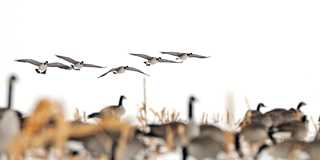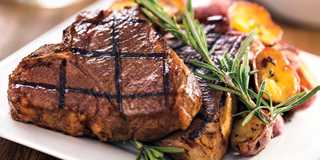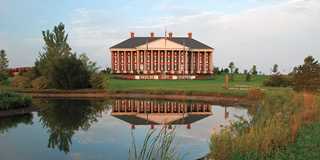Best of the Flyways: Central Flyway
From the Canadian Arctic to Mexico’s Yucatan Peninsula, the diverse landscapes of the Central Flyway provide a variety of options for hunters
From the Canadian Arctic to Mexico’s Yucatan Peninsula, the diverse landscapes of the Central Flyway provide a variety of options for hunters

From the Canadian Arctic to Mexico's Yucatan Peninsula, the diverse landscapes of the Central Flyway provide a variety of options for hunters. Visiting the Prairie Pothole Region is a pilgrimage of sorts for those who understand the importance of this area for breeding waterfowl. Travel to the other end of the flyway, along the Gulf Coast, and you'll begin to understand the vast geography these birds cover on their annual journeys. At stops all along these migratory pathways, hunters head to the field to bear witness to this timeless wildlife spectacle.

The glacial wetlands and grasslands of Saskatchewan offer some of the most productive duck breeding and nesting habitat in North America. Birds hatched in this vital portion of the Prairie Pothole Region fuel early-season hunting. As fall progresses and additional ducks and geese arrive from the north, the skies come to life with mile-long lines of snow geese and swarms of mallards and pintails.
When to Go
Geese are a popular target for hunters. Snows, Canadas, and white-fronted geese typically begin arriving in traditional staging areas, like the Quill Lakes region, in mid-September. By the end of the month, numbers of light geese covering fields of freshly swathed peas and barley can be staggering. Similar to the spring Light Goose Conservation Order, regulations in Saskatchewan allow the use of electronic calls to decoy light geese during fall. If freelancing, plan on one or two days of scouting on the front end of the trip to find concentrations of birds, identify feeding patterns, and secure permission from landowners.

Some hunters favor late September because of the more temperate weather and decreased chances of a season-ending freeze or snowstorm, but there are plenty of incentives to hunt in mid- to late October, when the field hunting for Canada geese and mallards can be phenomenal.
After the Hunt
Located at the junction of Highways 6 and 16 in Dafoe, the 24/7 Travel Centre is a popular stopping point for waterfowl hunters in the Quill Lakes region looking for clean accommodations or a quick snack. The star of this one-stop shop in the heart of the Saskatchewan prairie, however, is Sams Steakhouse, which offers up classic hearty fare, as well as traditional Greek and Canadian dishes.

Local Attractions
Visitors to the Western Development Museum in North Battleford can learn about the tall wooden grain elevators that stand as iconic symbols of this provinces deep connection to agriculture. If travel plans allow for extra days, be sure to check out world-class upland hunting for sharp-tailed grouse and Hungarian partridge in the southern portions of the province.
Ample public land, hunter-friendly accommodations, and a history of being the leading duck-producing state make North Dakota a reliable destination for waterfowlers. One of the main attractions of this prairie pothole state is the variety of waterfowl one might see. A North Dakota hunt can produce a bag limit that includes everything from blue-winged teal to giant Canada geese, wood ducks to canvasbacks, and everything in between.
When to Go
Special August and September seasons provide early opportunities for resident Canada geese over decoys in fields of harvested small grains or cut alfalfa. Scouting is key to success with these early birds, which tend to move in family groups and stick to established feeding patterns.
As the calendar flips from September to October, early migrants like blue-winged teal and pintails begin to depart their breeding grounds, but they are soon replaced by other ducks from the north. Waterfowl hunting can quickly come to a close in North Dakota with a round of frigid temperatures or snow. The late season is highlighted by opportunities to hunt hardy mallards and Canada geese on the Missouri River or in adjacent fields. Larger waters like Devils Lake also provide hot action for ducks and geese when the weather turns cold.
After the Hunt
If you find yourself in Woodworth, stop at Titos Tavern, where you wont walk out hungry and you wont leave as a stranger.
Local Attractions

Communities across North Dakota embrace the states waterfowl hunting heritage. In Gackle, Duck Fest takes over the town early in the season. In late October, Kenmare hosts Goose Fest, a weeklong celebration with friendly hunting competitions, a fish fry, and other social events.
Situated at the southern end of the Prairie Pothole Region, South Dakota offers a mix of open prairie, wetlands, row crops, and small grains east of the Missouri River, making it a top destination for waterfowl and waterfowl hunters. While competition in some areas can be high, freelancing is still a popular option for hunters looking for a do-it-yourself experience on public or private ground. South Dakota has a limit on the number of licenses available to nonresident waterfowl hunters, but the odds of drawing one are good. Applications are available in June.

In terms of gear, you can pack your trailer to target ducks and geese specifically over water or in the field, but it pays to be prepared for a variety of situations. County plat books or an app like onX are must-haves for tracking down landowners to gain permission.
When to Go
South Dakotas wetlands and surrounding uplands can produce a bumper crop of waterfowl when conditions are right. By late September, locally raised ducks and geese can be found feeding in fields of harvested small grains. The state typically receives a push of calendar birds, like gadwalls and wigeon, in late October, and the Veterans Day holiday is often accompanied by a cold front that brings an influx of migrating mallards, Canada geese, and snow geese from the north. These birds stage at historical stopping points like Sand Lake National Wildlife Refuge near Aberdeen. Late in the season, waterfowl congregate on remaining stretches of open water on the Missouri River, prairie lakes, or other large bodies of water, where they remain until extreme cold and snow force them south.
After the Hunt
The northeast corner of South Dakota traditionally produces some of the states best waterfowl hunting, and you can hear stories from the days hunt at the Decoy Bar on the south end of Main Street in Webster. Dont be afraid to drive straight there from the field or the marsh—the Decoy Bar is the type of place where you look out of place if youre not wearing at least a little bit of camouflage.
Local Attractions

Terry Redlins warm paintings of outdoor scenes set against rural backdrops make him one of the worlds most popular and recognizable wildlife artists. Fans of this South Dakota native can roam through a collection of his work at the Redlin Art Center in Watertown.
When cold weather and snow push mallards out of their breeding grounds in the northern reaches of the flyway, Kansas becomes a prime destination for birds moving south. In extreme north-central Kansas, state-
managed wetlands at Jamestown Wildlife Area attract migrating mallards, along with other varieties of ducks and geese. When ice covers the regions shallow wetlands, mallards will often shift to the open waters found on local reservoirs or gravel pits, and feed in the surrounding fields.
Located near Great Bend, the 20,000 acres of wetlands on Cheyenne Bottoms Wildlife Area are managed for use by migrating mallards and other waterfowl. Hunting pressure and water levels have a significant impact on opportunities here, and visitors should keep tabs on both before making the trip.
In recent years, eastern Kansas has gained a reputation for some of the flyways best mallard hunting on public and private ground that is managed for ducks, including flooded green-timber and moist-soil units. State-managed Marais des Cygnes and Neosho Wildlife Areas are among the more popular public destinations.
When to Go
Waterfowl hunters in Kansas are largely dependent on weather systems in Canada, the Dakotas, and Nebraska to push mallards and other ducks and geese into the state starting in late October or early November. But waterfowl numbers in the state will also see a boost when freezing temperatures give way to a December or January thaw that draws birds back north from wintering areas to the south.
After the Hunt

In Stafford, which is south of Cheyenne Bottoms, check out Joans Cafe, a home-style restaurant famous for satisfying the cravings of hungry patrons. Try the chicken-fried steak or biscuits and gravy.
From north to south, hunters traveling to Texas can find tremendous waterfowl hunting opportunities. In the Panhandle, hunters pursue mallards, pintails, wigeon, gadwalls, and more on the regions shallow playa lakes, as well as large numbers of lesser Canada geese and sandhill cranes. When freezing temperatures arrive, birds shift to the areas reservoirs and other deeper waters to roost. Harvested fields of corn and sorghum can provide hot action over decoys, and the small Canada geese love to eat the short, tender shoots of newly emerged winter wheat.

Along the Texas coast, waterfowl hunting is anchored by the massive 24,500-acre J.D. Murphree Wildlife Management Area near Port Arthur, which contains the largest contiguous tract of coastal marsh in the state. A diverse mix of wetland habitat attracts significant numbers of wintering gadwalls, blue-winged and green-winged teal, and canvasbacks, and the area is also heavily used by local mottled ducks. Hunts on J.D. Murphree are first-come, first-served, and boats are necessary to access most of the hunting areas. Because of the heavy boat traffic, duck concentrations shift frequently, making scouting a daily priority.
When to Go
From September hunts for blue-winged teal over a playa lake near Amarillo to a hunt in shirtsleeves for redheads on Laguna Madre in January, there really isn't a bad time to hunt in Texas. A migration of ducks into the state in early November usually provides the first real push of birds into the northern region, and additional migration events are usually spurred by winter weather systems in Nebraska, Kansas, and Oklahoma.
After the Hunt
Just minutes after loading up after a hunt on J.D. Murphree WMA, you can find yourself enjoying one of the best bowls of shrimp etouffee in southeast Texas at Larry's French Market. From boudin to crawfish boils and everything in between, this popular restaurant will tempt your taste buds with local flavors and bet-you-can't-resist-it bread pudding.
Cast and Blast

The coastal region is tailored for a trip that combines a morning of wingshooting for dabblers and divers with an afternoon or evening of fishing for redfish, speckled trout, or flounder. A guide is recommended for anglers not familiar with a particular area, but there are numerous options for anyone wishing to launch their own boat.
Ducks Unlimited uses cookies to enhance your browsing experience, optimize site functionality, analyze traffic, and deliver personalized advertising through third parties. By continuing to use this site, you agree to our use of cookies. View Privacy Policy